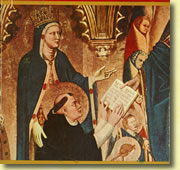William G. Witt
 In his book The God of Faith and Reason, the philosophical theologian Robert Sokolowski has argued that the Christian doctrine of creation is the unique element in the Christian understanding of the relation between God and the world.(1) According to Sokolowski, “the way creation is understood in Christian faith makes the Christian understanding of the divine different from the religious understanding achieved in natural experience and in other religious traditions.”(2)
In his book The God of Faith and Reason, the philosophical theologian Robert Sokolowski has argued that the Christian doctrine of creation is the unique element in the Christian understanding of the relation between God and the world.(1) According to Sokolowski, “the way creation is understood in Christian faith makes the Christian understanding of the divine different from the religious understanding achieved in natural experience and in other religious traditions.”(2)
Sokolowski’s thesis was anticipated in the studies of several (primarily Thomist) scholars who had earlier found the doctrine of creation to be the controlling factor in Thomas Aquinas’s formulation of that relation. Étienne Gilson, for instance, has contrasted Aquinas’s formulation of the relation between God and the world with that of the Greek philosophers who preceded him and concluded that the Christian understanding of God as “He who is”—as the God who requires nothing outside himself for his perfection and who is the self-sufficient Creator of all that is, and its corollary—that all finite and contingent beings must freely be given existence through God’s creative act, led Aquinas (in a philosophical advance over the “essentialist” ontologies of the Greeks) towards a Christian “existentialism,” i.e., the recognition that existence is ontologically prior to essence.(3) Josef Pieper (in The Silence of St. Thomas) declared that the notion of creation is the “fundamental idea” around which the structures of Thomas’s philosophy are organized. According to Pieper, “the notion of creation determines and characterizes the interior structure of nearly all the basic concepts in St. Thomas’s philosophy of Being.”(4)
Those who have looked to Aquinas’s formulation of the relation between God and the world have focused primarily on what Sokolowski calls the Christian “distinction” between God and creation — the distinction expressed in the assertion that God created the world freely out of nothing, and its corollaries. For instance, if God has created the world, he is in no way to be identified with it. God is not one of the “things” in the world he has created. No doubt this distinction lies at the heart of the Christian understanding of the God-world relation and must play a central role in any discourse concerning that relation. Nevertheless, it is not the only theme that needs to be considered in theological discussion about God and creation. This distinction (between God and everything else) raises further problems, e.g., problems of religious language. If God is radically distinguished from the world, and is thus outside our immediate experience, how can we talk about him? If attempted solutions emphasize the inherently symbolic, metaphorical, and analogical nature of religious language, a new problem appears. In spite of our inability to have a proper concept of God, we find ourselves speaking of God and God’s relation to creatures. Our understanding of God and of this relation must be expressed in a manner that is colored by the images and metaphors with which it is imagined and articulated. What principal controls the metaphors? In times past deity has been pictured in various ways—as a tinkering demiurge doing the best he can with intractable material (Plato’s Timeaus), as omnipotent will exerting sheer power over nothingness (Calvinism), as an absent-minded mathematician or watchmaker who now has better things to do (Deism), and as a fellow struggler who needs our help to get the job done (process theology). Thomas Aquinas’s own paradigm (based on the structures of human knowing and willing) is not quite like any of these.
The place of the doctrine of creation as an implicit yet overarching theme in Aquinas’s theology invites further reflection. In what follows I would like to examine St. Thomas’s use of the Christian understanding of creation as a tool by which he articulated the relation between God and the worldùnot as he explicitly discussed the question in his treatise on creation, but as it appears as the implicit (and sometimes explicitly stated) presupposition behind St. Thomas’s treatise on God (Summa Theologiae 1.2-26). Three elements in Thomas’s discussion of that relation will be considered: first, the distinction between God and the world; second, the problem of language about God and similarity between God and the world (Analogy and Participation); and, finally, the metaphor or model used by Aquinas to illustrate the relation between God and the world he has created—intentionality.
In addition, Aquinas’s own contribution in these three areas will become more readily apparent if it is compared with the attempts of other Medieval thinkers to deal with these same problems. Thomas’s articulation of the distinction between God and the world will be compared to the Neoplatonic emanationist schema of the Islamic philosopher Ibn Sina. Thomas’s discussion of religious language will be seen against the via negativa of the Jewish philosopher Moses ben Maimon (Maimonides), and, finally, Thomas’s utilization of intentionality as the chief metaphor to illustrate the doctrine of creation will be contrasted with the voluntarism characteristic of some late Medieval Augustinian thinkers, and largely shared by the Protestant Reformers.(5)
1. See Appendix.
2. Robert Sokolowski, The God of Faith and Reason: Foundations of Christian Theology (Notre Dame, IN: University of Notre Dame Press, 1982), xi.
3. Étienne Gilson, Being and Some Philosophers (Toronto Pontifical Institute of Mediaeval Studies, 1952); Christian Philosophy (Toronto: Pontifical Institute of Mediaeval Studies. 1993); The Christian Philosophy of St. Thomas Aquinas (Random House, University of Notre Dame Press, 1956, 1994); God and Philosophy (New Haven, CT.: Yale University Press, 1941, 1979).
4. Josef Pieper, The Silence of St. Thomas, trans. J. Murray and D. O Conner (New York, 1957), 48. Also see Pieper, Guide to Thomas Aquinas (San Francisco: Ignatius Press, 1991).
5. Contrasting Aquinas with other Medieval thinkers in order more starkly to bring out his own unique contribution is not original. Gilson used the technique throughout his career. David Burrell compares and contrasts Aquinas with Ibn-Sina and Maimonides in Knowing the Unknowable God: Ibn-Sina, Maimonides, Aquinas (University of Notre Dame Press, 1986) and Freedom and Creation in Three Traditions (University of Notre Dame Press, 1993). Burrell contrasts Aquinas with Duns Scotus in “Aquinas and Scotus: Contrary Patterns for Philosophical Theology,” Theology and Dialogue: Essays in Conversation with George Lindbeck, ed. Bruce D. Marshall (University of Notre Dame Press, 1990). Heidegger and process theologians are William Hill’s favorite tools for contrast and comparison in Search for the Absent God: Tradition and Modernity in Religious Understanding (NY: Crossroad Publishing Company, 1992).



Doesn’t his doctrine of participation moderate the radical “otherness” of the Creator from the creature? If the creature only exists because it shares in God’s existence there is a link between the two. But the creature depends on the Creature and the Creator does not depend on the creature and thus God’s independence is preserved.
Comment by Seretha — October 2, 2009 @ 7:02 am